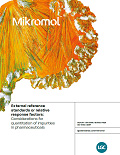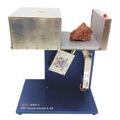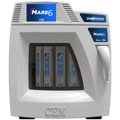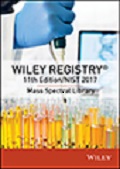
|
|
|
|
| Spectroscopy Spotlight |
|
| Detection and Identification of Individual Nanoparticles Using Laser-Induced Breakdown Spectroscopy (LIBS)
|
|
As the use of nanoparticles in a wide range of applications continues to increase, the need for techniques to analyze these particles also grows. Javier Laserna of the University of Málaga, in Spain, has developed an approach to measure individual nanoparticles in air using optical trapping (OT) combined with laser-induced breakdown spectroscopy (LIBS). Laserna received the 2018 Lester W. Strock award for this development as well as his broader research on analytical methods and instrumentation using LIBS. He recently spoke to us about this work.
Read more
|
|
|
|
Subscribe |
|
Subscribers can enjoy each full issue of Spectroscopy in print, or via Spectroscopy apps.
subscription offers |
 |
|
|
|
|
|
|
| Featured Articles |
|
| SEC–ICP–OES Hyphenation: Speciation and Quantification of Polydimethylsiloxanes at Trace Levels
|
|
Polydimethylsiloxane (PDMS) compounds are ubiquitous; thus it is challenging to develop analytical methods that ensure their absence. A newly developed method combining size-exclusion chromatography with inductively coupled plasma–optical emission spectroscopy makes it possible to quantify ultratrace levels of PDMS in volatile and nonvolatile organic solvents. A complete range of molecular weights can also be distinguished with this approach.
Read more |
|
|
|
| Advertisement |
|
Hear the latest technical advancements for sensors, infrared technology, laser systems, spectral imaging, radar, LiDAR, and more at SPIE Defense + Commercial sensing 2019. Learn about current and future applications in areas such as autonomous systems, agriculture and manufacturing. Come hear plenary speakers from USC, ARL and DARPA. Plan to learn, network and do business 14-18 April 2019 in Baltimore.
 Learn more Learn more |
|
|
| The 2019 Emerging Leader in Atomic Spectroscopy Award
|
|
This year's Emerging Leader in Atomic Spectroscopy, Dominic Hare, is a forerunner in developing laser ablation–inductively coupled plasma–mass spectrometry methods for in situ analysis of trace elements in tissue to investigate the presence of biometals related to neurodegenerative diseases.
Read more |
|
|
|
| Advertisement |
|
15th International Conference on Laser Ablation
Location: Westin Maui Resort & Spa, Kaanapali, Maui-Hawaii, USA
Dates: September 8-13, 2019
The International Conference on Laser Ablation (COLA) is the premier conference in the field of laser ablation and applications. Since 1991, COLA has been bringing together laser scientists, end-users and industry to review state-of-the-art and next-generation laser ablation technologies. COLA is an interdisciplinary conference and the topics cover a wide range of scientific research that bridges the gap between basic science and applications / technology.  Learn more Learn more |
|
|
|
|
| Advancing Laser–Ablation ICP–MS |
|
Jorge Pisonero of the University of Oviedo studies the performance of the laser ablation process in laser ablation–inductively coupled plasma–mass spectrometry, examining aspects such as the morphology of the craters created during sampling and the role of laser fluence. He also studies the effect of these factors in specific applications of LA–ICP–MS. He recently spoke to us about this work.
Read more |
|
|
|
| Advertisement |
|
Discover the Latest Advances in ICP-OES and ICP-MS Techniques
Tuesday, February 19, 2019 at 11am EST / 8am PST / 4pm GMT / 5pm CET
 Register Now Register Now |
|
|
|
| Portable Spatially Offset Raman Spectroscopy for Rapid Hazardous Materials Detection Within Sealed Containers |
|
Portable spatially offset Raman spectroscopy (SORS) enables rapid identification of materials concealed by a wide variety of nonmetallic sealed containers. This technique has been successfully used by the military, first responders, and customs and law enforcement operators in the detection of explosives, chemical agents, precursors and hazardous narcotics, thus enabling the acquisition of better information without disturbing the materials in question.
Read more |
|
|
|
| Advertisement |
|
Re-think Quantitative Analysis: Solutions for Challenging Measurements
On Demand
 Learn more Learn more |
|
|
|
| A Simple and Effective ICP-MS Method Capable of Detecting Trace and Major Elements in Milk Samples |
|
The method described here is a simple method for detection of a wide spectrum of metals and for quantitative analysis over a wide dynamic range of elements, including both toxic metals and those metals essential for health and well-being.
Read more |
|
|
|
| Advertisement |
|
The Role of Raman Spectroscopy in the QA/QC Laboratory
On Demand
 Learn more Learn more |
|
|
|
|
|
| Application Note |
|
 |
|
|
|
|
| Featured PRODUCTS |
|
 |
|
|
|
|
 |
|
| Mini-Benchtop Lasers for Raman |
|
The BT Series of wavelength-stabilized lasers from Ondax, now a Coherent company, is ideal for Raman setups, delivering fiber-connectorized output in an ultra-compact footprint: wavelengths from 405 nm to 1064 nm.
 Learn more Learn more |
|
|
|
 |
|
| MARS 6 Microwave Digestion |
|
The secret to better trace metals analyses lies in better sample prep. The CEM MARS 6 microwave digestion system is a world-class lab microwave ready to digest all your samples.
 Learn more Learn more |
|
|
|
 |
|
| Go beyond the standard |
|
With over 1.6 million spectra, Wiley Registry 11th edition / NIST 2017 is the broadest combined mass spectral library available. Increase your coverage and confidently identify unknowns with Wiley.
 Learn more Learn more |
|
|
|
|
|
|
|
|
|

